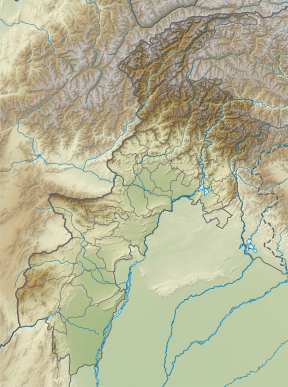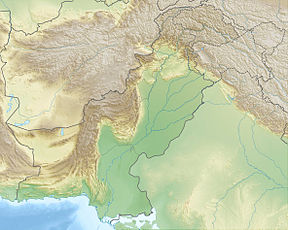This article has multiple issues. Please help improve it or discuss these issues on the talk page. (Learn how and when to remove these messages)
|
Mount Sikaram (Pashto, Dari, Urdu: سیکرم) is a mountain on the Afghanistan–Pakistan border, south of the Kabul River and Khyber Pass. At 4,755 m (15,600 ft),[1] it is the highest peak of the Spīn Ghar, or Safēd Kōh, mountain range.
| Mount Sikaram | |
|---|---|
 Mount Sikaram viewed from the Kurram Valley | |
| Highest point | |
| Elevation | 4,755 m (15,600 ft)[1] |
| Prominence | 2,295 m (7,530 ft)[1] |
| Listing | Ultra |
| Coordinates | 34°02′18″N 69°54′09″E / 34.03833°N 69.90250°E[1] |
| Naming | |
| Native name | سیکرم (Urdu) |
| Geography | |
Location in the Western Himalayas on Afghanistan–Pakistan border | |
 | |
| Location | Afghanistan–Pakistan Border |
| Countries | Afghanistan and Pakistan |
| Provinces/Districts | Logar, Paktia and Parachinar |
| Parent range | Spin Ghar, Hindu Kush, Western Himalayas |
Location
editMount Sikaram is located north of the village of Peshawar in the Kurram District of Pakistan’s Khyber Pakhtunkhwa province. Its parent range, Spīn Ghar connects directly with the Shandūr offshoot of the Hindu Kush mountain system. Atop the range, temperatures can fall below 0 °C (32 °F) at any time of the year.[citation needed]
A small valley on the slope of Mount Sikaram encompasses a number of villages, districts, and tribal regions—many historically significant—including Peiwar, Alizai, Tari Mangal, Narai, Speena Shaga, and Khewas. The Gawi Pass, also known as the Peiwar Kotal Pass, runs between the Kurram Valley and Afghanistan's Aryub Valley; it connects the Paktia Province of Afghanistan with the Kurram District of Khyber Pakhtunkhwa province in the former FATA region of Pakistan.
History
edit- 1878 British forces were victorious over Afghan forces and seized control of the Peiwar Pass in the Battle of Peiwar Kotal.
- 1878-1879 British surveyor George Batley Scott climbed the mountain during a campaign to survey Afghanistan.[2]
See also
editReferences
edit- ^ a b c d "Afghanistan and Central/Southern Pakistan". Peaklist.org. Retrieved 2014-05-27.
- ^ Boleslaw Chwaściński: The Exploration of the Hindu Kush. In: The Alpine Journal. Bd. 71, Nr. 2 = Nr. 313, 1966, S. 199–214, hier S. 203, (PDF; 6.5 MB).


